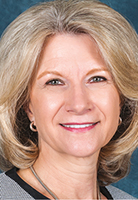
President's Corner
Mastering Time or Mastering Standards
By Gail Pletnick/
School Administrator, February 2018
 WHAT IF YOU
WHAT IF YOU walked into a physician’s office on a Monday feeling ill and were told that the doctor would do an examination that day, but only schedules medical tests on Fridays? Results from those tests are given to patients on Tuesdays and the physician provides diagnoses only on Wednesdays. Chances are you would walk out of that office and find another doctor.
What if your 2013 car began having transmission problems and you took it to your mechanic only to be told your car is not old enough to have transmission problems, so just keep driving it for at least another year, then come back and the mechanic will look at it? Once again, chances are you would not be returning to that auto garage.
Not everything in life fits perfectly into the schedules or time frames we create. Developments often arise before or after they are expected, and they may need attention sooner rather than later. Yet in many schools, seat time, bell schedules and academic calendars continue to define student learning with no exceptions.
How many teachers still introduce a spelling list or a math unit on a Monday and then, whether or not they need it or are ready, every child takes a test on Friday? The teacher then returns test scores on Tuesday and students prove they understand the missed concepts by turning in test corrections by Wednesday.
Then there is the concept that when a child turns age 5, he or she is ready for the first year of formal education. Five-year-olds entering the school system are expected to learn all kindergarten standards during that first year. But what if that child already has mastered the reading skills being taught or can demonstrate an understanding of the math concepts for that grade?
These situations leave parents feeling frustrated that the schools are not meeting the needs of the individual student, and families do walk away from the public school system because of those concerns. Nothing fits perfectly into the schedules and time frames we create — including learning.
As we redefine, redesign and reimagine our educational systems to ensure we prepare each and every child with the knowledge, skills and dispositions needed to be successful, we need to think about time and mastery differently.
Yes, there are standards that must be set, and we need to provide a continuum of learning for those standards, but we cannot persist in pretending that X number of hours of instruction per child equals the exact same learning and mastery of all standards for all students. It is amazing that we recognize and accept that not all children learn to walk or talk at exactly the same time. However, the minute a child enrolls in school, the expectation is that the student’s language development, problem-solving skills and processing will somehow magically sync with those of every other child in that classroom.
Redesigning the teaching and learning environment requires us to personalize learning for each child and recognize that mastering the standards must be our goal, not counting the minutes a child is exposed to a standard. When a child has shown mastery, he or she should move on. When a child struggles with a concept, he or she should be given the support and time to address that gap before moving on.
It sounds so simple, yet this is an area many schools struggle with because for so long our educational system has been driven by a traditional school calendar, school day and bell schedule. With the availability of technology and tools that allow us to more easily differentiate and personalize the teaching and learning environment, we now have the opportunity to stop measuring learning in minutes and start measuring it by the mastery of standards.
Gail Pletnick is AASA president in 2017-18. E-mail:
gail.pletnick@dysart.org. Twitter:
@GPletnickDysart